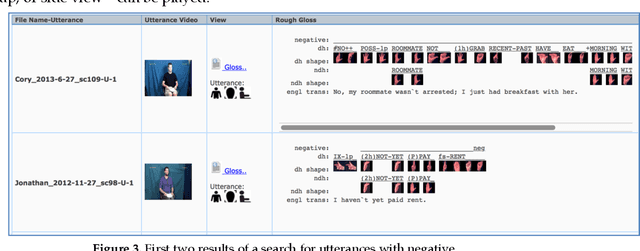Augustine Opoku
New Capability to Look Up an ASL Sign from a Video Example
Jul 18, 2024



Abstract:Looking up an unknown sign in an ASL dictionary can be difficult. Most ASL dictionaries are organized based on English glosses, despite the fact that (1) there is no convention for assigning English-based glosses to ASL signs; and (2) there is no 1-1 correspondence between ASL signs and English words. Furthermore, what if the user does not know either the meaning of the target sign or its possible English translation(s)? Some ASL dictionaries enable searching through specification of articulatory properties, such as handshapes, locations, movement properties, etc. However, this is a cumbersome process and does not always result in successful lookup. Here we describe a new system, publicly shared on the Web, to enable lookup of a video of an ASL sign (e.g., a webcam recording or a clip from a continuous signing video). The user submits a video for analysis and is presented with the five most likely sign matches, in decreasing order of likelihood, so that the user can confirm the selection and then be taken to our ASLLRP Sign Bank entry for that sign. Furthermore, this video lookup is also integrated into our newest version of SignStream(R) software to facilitate linguistic annotation of ASL video data, enabling the user to directly look up a sign in the video being annotated, and, upon confirmation of the match, to directly enter into the annotation the gloss and features of that sign, greatly increasing the efficiency and consistency of linguistic annotations of ASL video data.
ASL Video Corpora & Sign Bank: Resources Available through the American Sign Language Linguistic Research Project (ASLLRP)
Jan 19, 2022



Abstract:The American Sign Language Linguistic Research Project (ASLLRP) provides Internet access to high-quality ASL video data, generally including front and side views and a close-up of the face. The manual and non-manual components of the signing have been linguistically annotated using SignStream(R). The recently expanded video corpora can be browsed and searched through the Data Access Interface (DAI 2) we have designed; it is possible to carry out complex searches. The data from our corpora can also be downloaded; annotations are available in an XML export format. We have also developed the ASLLRP Sign Bank, which contains almost 6,000 sign entries for lexical signs, with distinct English-based glosses, with a total of 41,830 examples of lexical signs (in addition to about 300 gestures, over 1,000 fingerspelled signs, and 475 classifier examples). The Sign Bank is likewise accessible and searchable on the Internet; it can also be accessed from within SignStream(R) (software to facilitate linguistic annotation and analysis of visual language data) to make annotations more accurate and efficient. Here we describe the available resources. These data have been used for many types of research in linguistics and in computer-based sign language recognition from video; examples of such research are provided in the latter part of this article.
 Add to Chrome
Add to Chrome Add to Firefox
Add to Firefox Add to Edge
Add to Edge